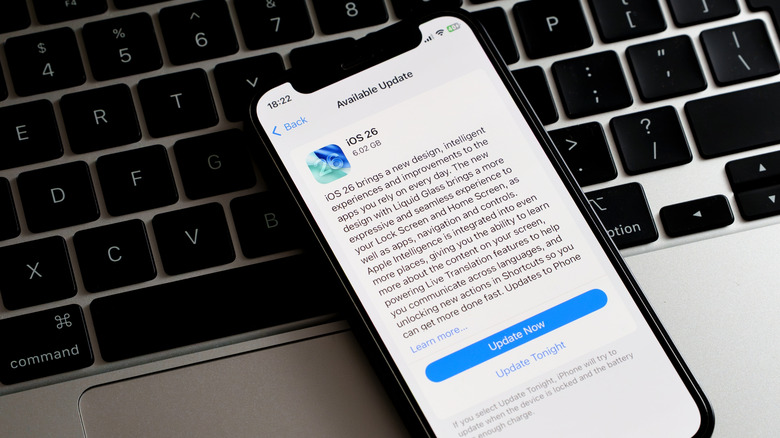Can't Update Your iPhone Or iPad To iOS 26? Here Is The Most Likely Reason Why
Every September, pretty much every social platform gets flooded with people showing off the latest iOS update. This year, Apple's new software lineup dropped on September 15th, and includes watchOS 26, tvOS 26, macOS Tahoe, and of course, iOS 26 and iPadOS 26.
While Apple always goes all in with its software updates, this year's releases are especially massive, both in features and design changes. For instance, the UI across Apple devices looks quite different compared to previous years, thanks to a new design language called Liquid Glass. Along with the transparent new look, Apple also introduced neat features like Call Screening, estimated charging time, Live Translation, and more.
While the majority of Apple users have likely already jumped on the iOS 26 and iPadOS 26 bandwagon, plenty of iPhone and iPad owners may notice they can't update their devices to the newest version at all. If that's the case for you, the most likely reason is simple: your device is no longer supported.
iOS 26 or iPadOS 26 isn't available on your device
When a new software update drops on any platform, older devices slowly fall off the support list as the years go by. Apple is no exception. Each year, when the company rolls out its big iOS and iPadOS updates, it quietly trims a few iPhones and iPads from support. This means if your device is a few years old, there's a good chance it won't be eligible for iOS 26.
In the case of iOS 26, you should be good to install it if your iPhone is from series 11 through 16. iOS 26 is also compatible with the iPhone SE (Gen 2) and, of course, new devices Apple launched this fall, including the iPhone 17, 17 Pro, 17 Pro Max, and the all-new 17 Air. The iPHone 17 series ships with iOS 26 preinstalled, so you won't need to go through the update process manually.
For iPads, your devices can run iPadOS 26 if they're one of these models:
- iPad (A16)
- iPad (8th generation or later)
- iPad Air (M3/M2)
- iPad Air (3rd generation or later)
- iPad Pro (M4)
- iPad Pro 11-inch (1st generation or later)
- iPad Pro 12.9-inch (3rd generation or later)
- iPad mini (A17 Pro)
- iPad mini (5th generation or later)
Unfortunately, if your device falls outside these lists, you won't be able to update to iOS 26 or iPadOS 26. While Apple may continue releasing security patches, you won't get the new features or design changes that come with this year's update.
Have a compatible model? You might not have enough storage
If your iPhone is a compatible model and you still can't install iOS 26, you might just be checking the wrong thing. Instead of compatibility, the real issue could be that your iPhone or iPad doesn't have enough free storage available to download iOS 26 or iPadOS 26. Though Apple hasn't publicly revealed exactly how much storage the update needs, it's best to have around 10GB of free space available on your device.
When I downloaded iPadOS 26 on my device, I had 20GB of free space, and the Settings page mentioned that 5GB was required for the update. This number can vary depending on the model; the easiest way to confirm is to try downloading the update yourself.
If you realize the issue is due to limited storage space, the next step is to clean up your iPhone's storage. The best place to start is by heading to Settings > General > iPhone/iPad Storage and analyzing which apps and files are taking up the most space. From there, you can do the basics: delete old photos and videos, back them up to iCloud or your preferred cloud storage, offload unused apps, and more. You'll follow the same steps to clear your iPad's storage if necessary, after which you should be able to install iOS 26.


